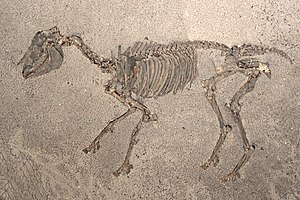Höwenegg
| Höwenegg | ||
|---|---|---|
|
Quarry and lake where the main castle used to be |
||
| height | 798 m above sea level NHN | |
| location | Baden-Wuerttemberg , Germany | |
| Mountains | Hegau | |
| Coordinates | 47 ° 54 ′ 52 " N , 8 ° 44 ′ 30" E | |
|
|
||
| rock | basalt | |
| Age of the rock | ~ 10 million years | |
| particularities | Due to mining, an original secondary peak is now the highest point of the mountain; original height of the main summit: 812 m. | |

The Höwenegg is a volcanic complex three kilometers south of Immendingen in the Tuttlingen district . The basalt cone , which was once 812 meters high and now only 798 meters high, was once the location of two castles and is geologically one of the Hegau mountains . It is the northernmost of the Hegau volcanoes.
mountain
At Höwenegg, like at Hohenstoffeln , basalt was mined for road construction in earlier times. As a result, the entire southern flank of the mountain has been removed. The hard basalt was still being mined until 1979, and this resulted in an 85-meter-deep pit. After the quarry was closed, a lake was formed in it, fed by rain and groundwater .
In the 1930s, when a drainage tunnel was being built for the quarry, larger fossil finds were made. Between 1950 and 1963, researchers like Max Pfannenstiel carried out 13 excavation campaigns lasting several weeks at Höwenegg. They discovered the completely preserved skeleton of the three-toed original horse Hipparion . The petrification is exhibited today in the State Museum of Natural History in Karlsruhe . The quarry is a mineral discovery site and the type locality of the rare mineral amicite . Other mineral finds from Höwenegg can be seen in the Princely Fürstenberg collections, among others.
Castles
On the Höwenegg once stood Castle Hewenegg (as Junghewen, Höwenegg or main castle called), and north of it on a 798-meter-high summit Besides its outer bailey , also Burgstall or Little Castle called. The main castle was built around 1100, the first known mention dates back to 1291. The owners were the Lords of Hewen and, from 1404, the Counts of Lupfen- Stühlingen. In 1639 the main castle was destroyed and used as a quarry in the following years. Later the castle site fell victim to basalt mining, its former location was at the point where the lake is today.
The outer bailey was also built around 1100, the first known mention comes from the year 1291. The complex was already abandoned in the 15th century and fell into disrepair. Today only remains of the wall are preserved, as the ruins were used as a quarry in the early 20th century.
Protected areas
On June 24, 1983, the mountain, together with the remains of the outer bailey and the quarry, was placed under nature protection by ordinance of the Freiburg Regional Council with the protected area number 3.128 . The " Höwenegg " nature reserve is 20.7 hectares in size. The same area is designated as the European bird sanctuary (SPA area) " Höwenegg ".
The Höwenegg volcanic crater has been an important geotope and geopoint of the UNESCO Geopark Swabian Alb since 2020 .
See also
literature
- Hans-Wilhelm Heine : Studies on weir systems between the young Danube and western Lake Constance . In: Landesdenkmalamt Baden-Württemberg (Hrsg.): Research and reports on the archeology of the Middle Ages in Baden-Württemberg . Volume 5. Stuttgart 1978, ISSN 0178-3262
- Friedrich-Wilhelm Krahe: Castles of the German Middle Ages. Floor plan lexicon. Weidlich / Flechsig, Würzburg 1994, ISBN 3-8035-1372-3
Web links
Individual evidence
- ↑ Citizens' Service Immendingen, information board of the Immendingen community 'on site'
- ↑ H. Tobien: On the ecology of the young tertiary mammals from Höwenegg / Hegau and on the biostratigraphy of the European Hipparion fauna . In: Writings of the Association for History and Natural History of the Baar in Donaueschingen . Volume 24, 1956, pp. 208-223
- ↑ a b Alexander Michel: [From Neanderthals to the Romans: 15 archaeological treasure troves in the region http://www.suedkurier.de/region/region/Von-Neandertalern-bis-zu-den-Roemern-15-archaeologische- Treasure trove-in-the-region; art552149,8151746 ] . In: Südkurier from September 15, 2015
- ↑ Höwenegg at mindat.org .

